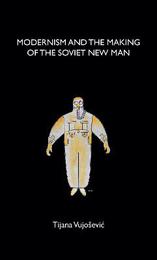
|
Modernism and the Making of the Soviet New Man
Paperback / softback
Main Details
| Title |
Modernism and the Making of the Soviet New Man
|
| Authors and Contributors |
By (author) Tijana Vujosevic
|
| Physical Properties |
| Format:Paperback / softback | | Pages:208 | | Dimensions(mm): Height 216,Width 138 |
|
| Category/Genre | Landscape art and architecture
History of architecture |
|---|
| ISBN/Barcode |
9781526114884
|
| Classifications | Dewey:720.947 |
|---|
| Audience | | General | | Tertiary Education (US: College) | | Professional & Vocational | |
|---|
| Illustrations |
72 black & white illustrations, 3 tables
|
|
Publishing Details |
| Publisher |
Manchester University Press
|
| Imprint |
Manchester University Press
|
| Publication Date |
25 January 2019 |
| Publication Country |
United Kingdom
|
Description
The creation of Soviet culture in the 1920s and the 1930s was the most radical of modernist projects, both in aesthetic and in political terms. Modernism and the Making of the New Man explores the architecture of this period as the nexus between aesthetics and politics. The design of the material environment, according to the author, was the social effort that most clearly articulated the dynamic of the socialist project as a negotiation between utopia and reality, the will for progress and the will for tyranny. It was a comprehensive effort that brought together professional architects and statisticians, theatre directors, managers, housewives, pilots, construction workers. What they had in common was the enthusiasm for defining the "new man", the ideal citizen of the radiant future, and the settings in which he or she lives. -- .
Author Biography
Tijana Vujosevic is Assistant Professor of Architectural History at the University of British Columbia -- .
Reviews'Vujosevic's Modernism and the Making of the Soviet New Man [...] argues for a history that transcends the opposition of the utopian and the real (or of noble dreaming and dismal totalitarianism) and exposes the complexity of the relationship between utopia and reality, idealism and pragmatism. [...] Engaging, witty, and captivating, Vujosevic's book rivals fiction without losing the conceptual rigor of an academic work. [..] Excellent, and long needed, pedagogical resources and important scholarly contributions that mark a new step in writing the conflicted history of Russian architecture.' Alla Vronskaya, Illinois Institute of Technology, Slavic and East European Journal, Vol. 62, No. 2 (Summer 2018) 'What is the relationship between utopia and reality ? And what role does space - broadly defined - play in answering that question ? These are the core subjects addressed in Tijana Vujosevic's intriguing new study of modernist expressions in architecture in 1920s and 1930s Soviet Russia. Her study is a welcome addition to a scholarly literature that tends to neglect architecture in favour of focusing on literature and the visual arts. With her fresh approach, Vujosevic demonstrates that ideas about space, and about how it can be used to recreate society, helped to define the New Soviet Person, first as a worker and then, as the 1920s gave way to the socialist-realist dominated 1930s, as a whole person.' Alison Rowley, Concordia University, RACAR, Vol. 43, No. 1 (2018) 'What happened in the process of making Soviet culture after 1917? Modernism and the Making of the New Soviet Man is a brilliant foray into a fascinating field of study, one that it also helps to constitute. It brings together design history and theory and critical theory and the everyday life practices, from the heroic to the comical and absurd, which made up the invention of communist culture in the aftermath of the October Revolution. It combines utopianism of differing kinds and levels with the practical modernism which set out to operationalize Bolshevik, and then Stalinist culture.' Peter Beilharz, Curtin University, Thesis Eleven (October 2018) 'With its interdisciplinary scope, focus on identity formation, and exploration of a broad range of revolutionary spatial representations, Vujosevic's book can be seen as an important attempt to depart from traditional architectural history [...] Modernism and the making of the Soviet New Man offers intriguing, original interpretations about the links between ideology, space, and the formation of class identity. An ambitious interdisciplinary investigation, it courageously explores a wide range of spatial and cultural forms, illustrated by a compelling range of images and texts. It also avoids the common trap of focusing only on the early revolutionary avant-garde period, instead spanning the full length of the Soviet revolutionary historical project.' Katerina Ruedi Ray, Journal of Architectural Education (February 2019) -- .
|